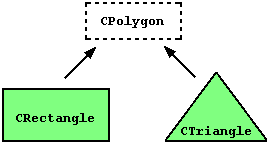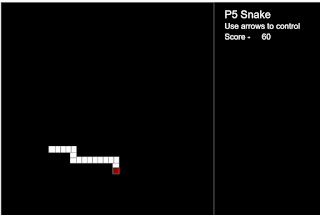Inheritance between classes
Classes in C++ can be extended, creating new classes which retain characteristics of the base class. This process, known as inheritance, involves a base class and a derived class: The derived class inherits the members of the base class, on top of which it can add its own members.For example, let's imagine a series of classes to describe two kinds of polygons: rectangles and triangles. These two polygons have certain common properties, such as the values needed to calculate their areas: they both can be described simply with a height and a width (or base).
This could be represented in the world of classes with a class
Polygon from which we would derive the two other ones:Rectangle and Triangle:
The
Polygon class would contain members that are common for both types of polygon. In our case: width and height. And Rectangle and Triangle would be its derived classes, with specific features that are different from one type of polygon to the other.Classes that are derived from others inherit all the accessible members of the base class. That means that if a base class includes a member
A and we derive a class from it with another member called B, the derived class will contain both member A and member B.The inheritance relationship of two classes is declared in the derived class. Derived classes definitions use the following syntax:
class derived_class_name: public base_class_name
{ /*...*/ };Where
derived_class_name is the name of the derived class and base_class_name is the name of the class on which it is based. The public access specifier may be replaced by any one of the other access specifiers (protected or private). This access specifier limits the most accessible level for the members inherited from the base class: The members with a more accessible level are inherited with this level instead, while the members with an equal or more restrictive access level keep their restrictive level in the derived class. | | 20 10 |
The objects of the classes
Rectangle and Triangle each contain members inherited from Polygon. These are: width,height and set_values.The
protected access specifier used in class Polygon is similar to private. Its only difference occurs in fact with inheritance: When a class inherits another one, the members of the derived class can access the protected members inherited from the base class, but not its private members.By declaring
width and height as protected instead of private, these members are also accessible from the derived classes Rectangle and Triangle, instead of just from members of Polygon. If they were public, they could be accessed just from anywhere.We can summarize the different access types according to which functions can access them in the following way:
| Access | public | protected | private |
|---|---|---|---|
| members of the same class | yes | yes | yes |
| members of derived class | yes | yes | no |
| not members | yes | no | no |
Where "not members" represents any access from outside the class, such as from
main, from another class or from a function.In the example above, the members inherited by
Rectangle and Triangle have the same access permissions as they had in their base class Polygon: | |
This is because the inheritance relation has been declared using the
public keyword on each of the derived classes: | |
This
public keyword after the colon (:) denotes the most accessible level the members inherited from the class that follows it (in this case Polygon) will have from the derived class (in this case Rectangle). Since public is the most accessible level, by specifying this keyword the derived class will inherit all the members with the same levels they had in the base class.With
protected, all public members of the base class are inherited as protected in the derived class. Conversely, if the most restricting access level is specified (private), all the base class members are inherited as private.For example, if daughter were a class derived from mother that we defined as:
| |
This would set
protected as the less restrictive access level for the members of Daughter that it inherited from mother. That is, all members that were public in Mother would become protected in Daughter. Of course, this would not restrictDaughter from declaring its own public members. That less restrictive access level is only set for the members inherited from Mother.If no access level is specified for the inheritance, the compiler assumes private for classes declared with keyword
classand public for those declared with struct.Actually, most use cases of inheritance in C++ should use public inheritance. When other access levels are needed for base classes, they can usually be better represented as member variables instead.





No comments:
Post a Comment